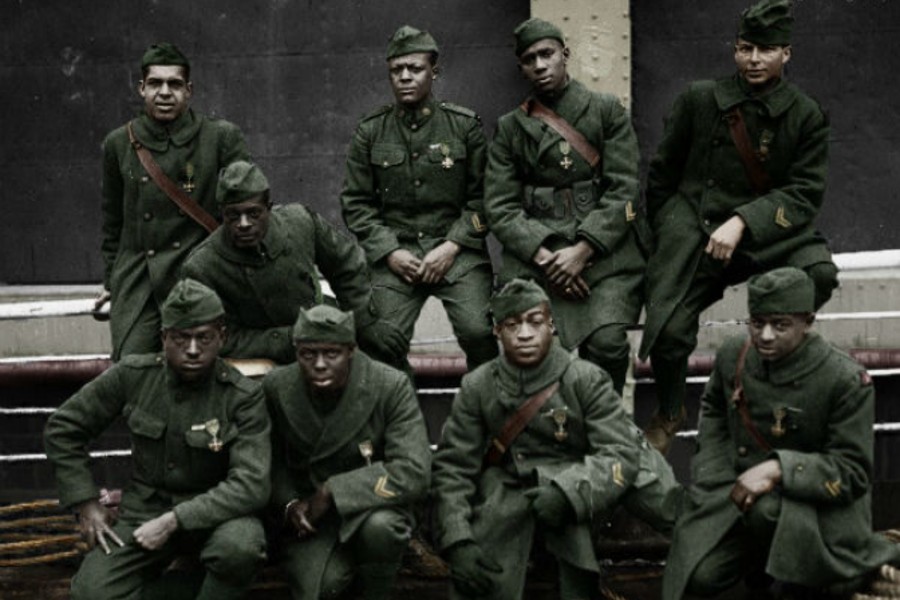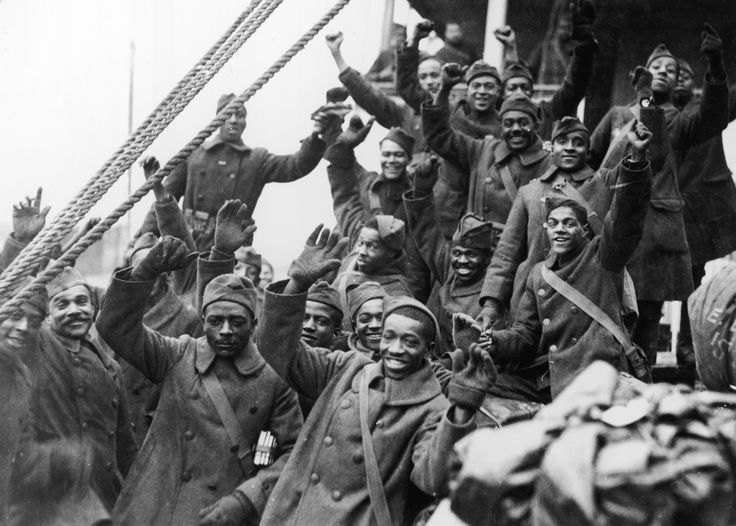
The 369th Infantry Regiment, formerly known as the 15th NY National Guard Regiment, was an infantry regiment of the US Army that saw action in World War I and World War II.
The Regiment consisted of African Americans and African Puerto Ricans and was known for being the first African-American regiment to serve with the American Expeditionary Force during World War I. Before the 15th New York National Guard Regiment was formed, any African American who wanted to fight in the war either had to enlist in the French or Canadian armies. The regiment was nicknamed the Harlem Hellfighters, the Black Rattlers and the Men of Bronze, which was given to the regiment by the French. The nickname “Hell Fighters” was given to them by the Germans due to their toughness and that they never lost a man through capture, lost a trench or a foot of ground to the enemy. The “Harlem Hellfighters” were the first all-black regiment that helped change the American public’s opinion on African American soldiers and helped pave the way for future African American soldiers.
“… the French held high opinions of black soldiers …”
On October 5, 1917, long-time secretary to Booker T. Washington, Emmett J. Scott was appointed Special Assistant to Newton D. Baker, the Secretary of War. Emmett was to serve as a confidential advisor in situations that involved the well-being of ten million African Americans and their roles in the war. While many African Americans who served in the Great War believed that, upon returning home racial discrimination would dissipate, that did not happen. Racial hatred after World War I was probably at its worst until the start of the Second World War. So with this American discrimination of African American soldiers, these troops were often sent to Europe where they were used to fill vacancies in the French Armies. Unlike the British, the French held high opinions of black soldiers which made for a more positive environment when working together. Ironically this made African American troops more passionate about fighting for America. This newly created patriotism by African Americans then led to the creation of the 369th Infantry Regiment.
The 369th Regiment was formed from the National Guard’s 15th Regiment in New York. The 15th Regiment was formed after Charles S. Whitman was elected Governor of New York. He enforced the legislation that was passed due to the efforts of the 10th Cavalry in Mexico which had passed as a law that had not manifested until June 2, 1913.
Once the United States entered World War I, many African Americans believed that entering the armed forces would help eliminate racial discrimination throughout the United States. Many African Americans felt that it was “a God-sent blessing” so that they could prove that they deserved respect from white Americans through service in the armed forces. Through the efforts of the Central Committee of Negro College Men and President Wilson had established a special training camp to train black officers for proposed black regiments.
“They’re our buddies. And we won’t buy from men who treat them unfairly.”
The 369th Infantry Regiment was constituted on 2 June 1913 in the New York Army National Guard as the 15th New York Infantry Regiment. The 369th Infantry was organized on 29 June 1916 at New York City. The infantry was called into Federal service on 25 July 1917 at Camp Whitman, New York. While at Camp Whitman, the 369th Infantry learned basic military practices. These basics included military courtesy, how to address officers, and how to salute. Along with these basics they also learned how to stay low and out of sight during attacks, stand guard and to march in formation. After their training at Camp Whitman, the 369th was called into active duty in New York. While in New York, the 369th was split into three battalions in which guarded rail lines, construction sites and other camps throughout New York. Then on 8 October 1917 the Regiment traveled to Camp Wadsworth in Spartanburg, South Carolina, where they received training in actual combat. Camp Wadsworth was set up similar to the French battlefields. While at Camp Wadsworth they experienced significant racism from the local communities and from other units. There was one incident in which two soldiers from the 15th Regiment, Lieutenant Europe and Noble Sissle, were refused by the owner of a shop when they attempted to buy a newspaper. Several soldiers from the white, 27th Division came to aid their fellow soldiers. Lieutenant Europe had commanded them to leave before violence erupted. Many other shops refused to sell goods to the members of the 15th Regiment, so members of the 27th and 71st Divisions told the shop owners that if they did not serve black soldiers they can close their stores and leave town. The white soldiers then stated “They’re our buddies. And we won’t buy from men who treat them unfairly.”
The 15th Infantry Regiment NYARNG was assigned on 1 December 1917 to the 185th Infantry Brigade. It was commanded by Col. William Hayward, a member of the Union League Club of New York, which sponsored the 369th in the tradition of the 20th U.S. Colored Infantry, which the club had sponsored in the Civil War. The 15th Infantry Regiment shipped out from the New York Port of Embarkation on 27 December 1917 and joined its brigade upon arrival in France. The unit was relegated to labor service duties instead of combat training. The 185th Infantry Brigade was assigned on 5 January 1918 to the 93rd Division.
The 15th Infantry Regiment, NYARNG was reorganized and re-designated on 1 March 1918 as the 369th Infantry Regiment, but the unit continued labor service duties while it awaited the decision as to its future.
The US Army concluded on 8 April 1918 to assign the unit to the French Army for the duration of the United States’ participation in the war. The men were issued French helmets and brown leather belts and pouches, although they continued to wear their U.S. uniforms. While in the United States, the 369th Regiment was never treated like similar all-white units. They were subject to intense racial discrimination and were looked down upon. In France, the 369th was treated as if they were no different from any other French unit. They did not show hatred towards them and did not racially segregate the 369th. The 369th finally felt what it was like to be treated equally. The French accepted the all black, 369th Regiment with open arms and welcomed them to their country.
The 369th Infantry Regiment was relieved on 8 May 1918 from assignment to the 185th Infantry Brigade and went into the trenches as part of the French 16th Division. It served continuously to 3 July. The regiment returned to combat in the Second Battle of the Marne. Later the 369th was reassigned to Gen. Lebouc’s 161st Division to participate in the Allied counterattack. On one tour they were out for over 6 months which was the longest deployment of any unit in World War I. On 19 August, the regiment went off the line for rest and training of replacements.
While overseas the Hellfighters saw propaganda for them saying that the Germans had done nothing wrong to blacks so why are they against them and that they should be against the American? These statements only made the African Americans even more devoted to the U.S.
On 25 September 1918, the French 4th Army went on the offensive in conjunction with the American drive in the Meuse-Argonne. The 369th turned in a good account in heavy fighting, sustaining severe losses. They captured the important village of Séchault. At one point the 369th advanced faster than French troops on their right and left flanks, and risked being cut off. By the time the regiment pulled back for reorganization, it had advanced fourteen kilometers through severe German resistance.
In mid-October, the regiment was moved to a quiet sector in the Vosges Mountains. It was there on 11 November, the day of the Armistice. Six days later, the 369th made its last advance and on 26 November, reached the banks of the Rhine River, the first Allied unit to reach it. The regiment was relieved on 12 December 1918 from assignment to the French 161st Division. It returned to the New York Port of Embarkation and was demobilized on 28 February 1919 at Camp Upton at Yaphank, New York, and returned to the New York Army National Guard.
“… who earned the nickname “Black Death” for his actions in combat in France.”
One Medal of Honor and many Distinguished Service Crosses were awarded to members of the regiment. The most celebrated man in the 369th was Pvt. Henry Lincoln Johnson, a former Albany, New York, rail station porter, who earned the nickname “Black Death” for his actions in combat in France. In May 1918 Johnson and Pvt. Needham Roberts fought off a 24-man German patrol, though both were severely wounded. After they expended their ammunition, Roberts used his rifle as a club and Johnson battled with a bolo knife. Reports suggest that Johnson killed at least four German soldiers and might have wounded 30 others. Usually black achievements and valor went unnoticed, despite that fact over 100 men from the 369th were presented with American and/or French medals. Among those honors Johnson was the first American to receive the Croix de Guerre awarded by the French government. This award signifies extraordinary valor. By the end of the war, 171 members of the 369th were awarded the Legion of Honor or the Croix De Guerre . Despite the fact that they were decorated upon returning to New York the 369th Regiment were not allowed to participate in Victory Parade of 1919. They were also disrespected by not being given a salute by the MP’s who were under orders not to.
Photographs show that the 369th carried the New York Regimental flag overseas. The French government awarded the regiment the Croix de Guerre with silver star for the taking of Séchault. It was pinned to the colors by General Lebouc at a ceremony in Germany, 13 December, 1918.
One of the first units in the United States armed forces to have black officers in addition to its all-black enlisted corps, the 369th compiled a war record equal to any other U.S. infantry regiment. It earned several unit citations along with many individual decorations for valor from the French government. The 369th Infantry Regiment was the first New York unit to return to the United States, and was the first unit to march up Fifth Avenue from the Washington Square Park Arch to their armory in Harlem. Their unit was placed on the permanent list with other veteran units.
In re-capping the story of the 369th Arthur W. Little, who had been a battalion commander, wrote in the regimental history From Harlem to the Rhine, that it was official that the outfit was 191 days under fire, never lost a foot of ground or had a man taken prisoner, though on two occasions men were captured but they were recovered. Only once did it fail to take its objective and that was due largely to bungling by French artillery support.
So by the end of the 369th Infantry’s campaign in World War 1, they were present in the Champagne–Marne, Meuse – Argonne, Champagne 1918, and Alsace 1918 campaigns in which they suffered nearly 1500 casualties. The 369th also fought in distinguished battles such as Belleau Wood and Chateau-Thiery. While fighting these battles, they served nearly six months on the front lines and earned many distinguished awards. These awards included the Croix de Guerre which is France’s highest military honor.
“… the 369th’s regimental band (under the direction of James Reese Europe) …”
The 369th Regiment band was relied upon not only in battle but also for morale. So by the end of their tour they became one of the most famous military bands throughout Europe. They followed the 369th overseas and were highly regarded and known for being able to immediately boost morale. While overseas the 369th Regiment made up less than 1% of the soldiers deployed but were responsible for over 20% of the territory of all the land assigned to the United States. During the war the 369th’s regimental band (under the direction of James Reese Europe) became famous throughout Europe. It introduced the until-then-unknown music called jazz to British, French and other audiences, and started an international demand for it.
At the end of the war, the 369th returned to New York City, and on 17 February 1919, paraded through the city. This day became an unofficial holiday of sorts for all of Harlem. Many black schoolchildren were dismissed from school so that they could attend the parade. With the addition of many adults, thousands of people lined the streets to see the 369th Regiment: the parade began on Fifth Avenue at 61st Street, proceeded uptown past ranks of white bystanders, turned west on 110th Street, and then turned onto Lenox Avenue, and marched into Harlem, where black New Yorkers packed the sidewalks to see them. The parade became a marker of African-American service to the nation, a frequent point of reference for those campaigning for civil rights. Multiple parades took place throughout the nation, many of these parades included all-black regiments, including the 370th from Illinois. These parades helped show some people who were incredibly racist that these soldiers were willing to fight for their country. Then In the 1920s and 1930s, the 369th was a regular presence on Harlem’s streets, each year marching through the neighborhood from their armory to catch a train to their annual summer camp, and then back through the neighborhood on their return two weeks later.
After the First World War, the regiment was spread out throughout New York and still maintained some military exercises. Then with the start of the Second World War, they were reorganized as the 369th Antiaircraft Artillery Regiment. They were then deployed to Hawaii and parts of the West Coast.
In 1933 the 369th Regiment Armory was created to honor the 369th regiment for their service. This armory stands at 142nd and Fifth Avenue, in the heart of Harlem. This armory was constructed starting in the 1920s and was completed in the 1930s. The 369th Regiment Armory was listed on the National Register of Historic Places in 1994.
In 2003 the New York State DOT renamed the Harlem River Drive as the “Harlem Hellfighters Drive.” This four-mile road has become a way to remember the Regiment that fought to defend France in the First World War. Then on September 29, 2006 a twelve-foot-high monument was unveiled to honor the 369th Regiment. This statue is a replica of a monument that stands in France. The monument is made of black granite and contains the 369th crest and rattlesnake insignia.
The 369th Infantry Regiment has continued to live on since World War 1. At the end of the First World War, they were still seen each year in a parade in which they marched throughout the streets of Harlem and onto a train that took them to a summer camp that they participated in each year. Then in World War II, the 369th Antiaircraft Artillery Regiment was formed. This regiment served in Hawaii and throughout much of the western coast. Then in more recent history the 369th Sustainment Brigade was formed and served in battles in Desert Storm, Iraqi Freedom, and even the War on Terror.
To those men and women who served to protect our lives and this great country, we thank you. If you are a veteran please share your thoughts in the comments section below.
Photo credit: 1) goodizen. 2-3) Via Wikipedia.
Become a Harlem Insider!
By submitting this form, you are consenting to receive marketing emails from: . You can revoke your consent to receive emails at any time by using the SafeUnsubscribe® link, found at the bottom of every email. Emails are serviced by Constant Contact











